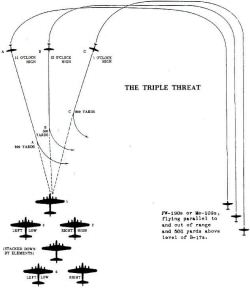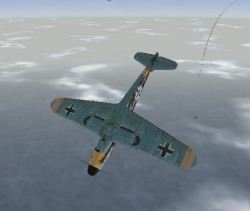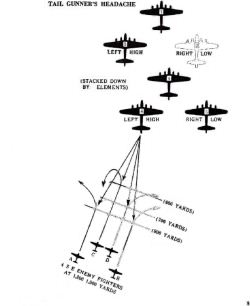|
German Fighter Tactics Against Flying Fortresses
Office of the Assistant Chief of Air Staff, Intelligence. Washington, D.C. |
||||
|
THE TRIPLE THREAT Lead Squadron of High Group, Any Combat Wing TACTICS DESCRIPTION This maneuver, as practically all other head-on attacks, is performed by single engine aircraft. The fighters, flying parallel to Fortresses as indicated in the diagram, pull ahead into positions at 11, 12, and 1 o'clock for commencment of their respective dives. At this time they are approximately 2,000/2,500 yards ahead and 500 yards above the level of the squadron to be attacked. They appear to be converging as they come head-on. Break-aways are made as follows:
Sometimes (as was done by "Goering's Abbeville Kids" in the Stuttgart mission on 6 September 1943), the dives are extended as indicated by the black lines in diagram, with slow rolls and belly-up dives (Split"S") underneath the squadron. The same diving attacks are often made from the rear of Fortress formaations. FW-190s and Me-109s can and do make these angular attacks, singly and head-on or from astern. Such attacks can be made from any clock position from 10 to 2 or from 4 to 8. TACTICS LESSON A slight turn will make all of these attacks a deflection shot. A slight dive or climb will uncover more turrets. |


 Go to The Double Queue
|
|||
|
Copyright © 1997 - 2000 COMBATSIM.COM, INC. All Rights Reserved. Last Updated August 8th, 1999 |
||||
